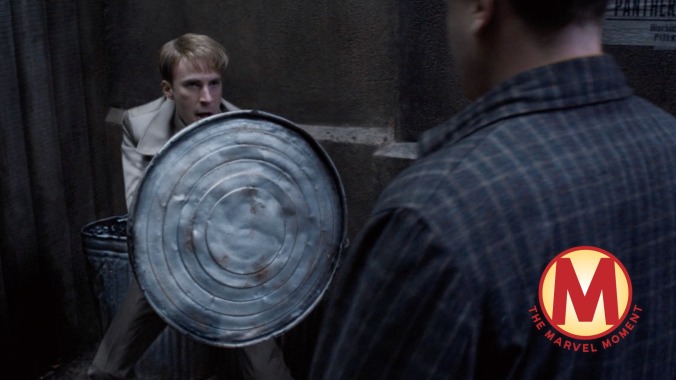With one line in Captain America: The First Avenger, Steve Rogers proves why he’s a hero


On paper, Captain America is a troublesome character. The George W. Bush era helped make it hard to see the United States as anything but a global bully, enforcing its will on others and shunning those who resisted. Just a few years later, Marvel Studios was trying to make a big-budget blockbuster about a superhero who is not only draped in the stars and stripes but literally called Captain America. Cap made sense as a propaganda tool in the ’40s, and Marvel had found a nice spot for him in the comics, but the company needed to do something special to avoid turning the movie into some jingoistic bullshit. As it turned out, that something special was puny Steve Rogers, getting his butt kicked in an alley before he ever joined up to fight in World War II.
Captain America: The First Avenger simply doesn’t work without establishing who Steve Rogers is before the super-soldier serum turns him into a buff sentinel of liberty. Using some occasionally iffy CG to make actual buff man Chris Evans look like a pipsqueak, the movie spends a good chunk of its early runtime hammering in the idea of why this skinny kid deserves an upgrade. The most effective scene, and the one that future movies repeatedly call back to, is Steve telling off a rude guy in a theater during a newsreel about the war and then getting dragged outside for a fistfight. The man is easily twice the size of little Steve and keeps knocking him down without breaking a sweat, but Steve keeps getting up, fighting not just for himself but for the ideals that this jerk disrespected when he complained about having to sit through war footage. Then the dummy sets little Steve up for a chance to drop what is essentially his MCU catchphrase by dismissing his seemingly weak opponent as someone who doesn’t “know when to give up.” Steve’s response: “I can do this all day.”
Evans’ Steve Rogers has become the heart of the MCU, and that moment—when it still seems impossible that this little guy could ever be putting on a superhero costume to save the world—proves it. With those six words, the movie establishes that Steve Rogers would be putting his life on the line to help people and to stand up for what he believes in even if he never became super strong and fast. Plus, after he does become strong and fast, he still holds on to this “never back down” attitude, dropping the exact same line in big fights with the Red Skull (later on in The First Avenger) and with Iron Man (in Captain America: Civil War). Later on in the movie, when Stanley Tucci’s Dr. Erskine is ready to choose Steve for the experiment that will turn him into Captain America, he tells Rogers that the most important thing is not him becoming the perfect soldier. It’s him staying true to who he is, “a good man.”
The other MCU heroes who had already been introduced have their own motivations for why they want to help people, whether it’s Tony Stark’s guilt over selling weapons for his whole life or Thor’s genuine love of adventure and smashing villains with his hammer. But Captain America just wants to be a good man because it’s the right thing to do. “I can do this all day” is simply who he is, super-soldier serum or not.
GET A.V.CLUB RIGHT IN YOUR INBOX
Pop culture obsessives writing for the pop culture obsessed.